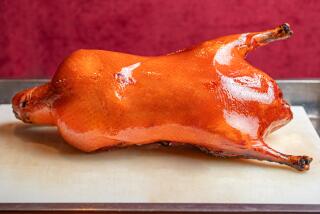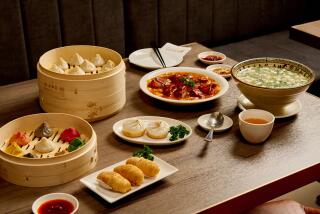FOOD : Dim Sum Desserts : A Blend of Traditions Gives Chinese Sweets a Distinctly Western Accent
- Share via
TAPIOCA PUDDING seems quintessentially American. So what is it doing on the dim sum carts of Chinatown restaurants? The answer can be found in Hong Kong--British colony, Canton ese city and home to expatriates from almost everywhere.
There, East and West are an age-old blend that has produced an unusual style of cooking. Cantonese chefs cater to Western tastes with such creations as lobster salad and sizzling steak. And over the years, Western desserts with a Cantonese twist have found their way onto menus in Hong Kong’s huge dim sum restaurants.
Now the dumplings, buns, meats and sweets known collectively as dim sum have become status food in Los Angeles, subject to trendy Western adaptations. But in Hong Kong-style restaurants, such as the new Empress Pavilion in Chinatown, they remain authentically Cantonese. And the cross-cultural desserts that accompany them seem comfortably familiar and easy to envision in less exotic settings.
Mango-flavored gelatin could follow chef’s salad and croissants at a women’s club luncheon. A pool party might wind up with shimmering white squares of coconut pudding or a chilled sweet soup garnished with honeydew. And hot tapioca pudding, its surface dappled golden brown, could join roast turkey and cranberry sauce on a Thanksgiving menu.
Still another dessert, Double Boiled Milk, caters to the contemporary Western taste for light foods, although it is thoroughly Cantonese. This fragile custard contains only four ingredients--milk, sugar, egg whites and a dash of fragrant ginger juice. Jimmy P. Y. Chiu, manager of the Empress Pavilion, says Cantonese women believe that eating it will make their skin beautiful. “Double boiled” means that the milk is cooked twice, first to scald it and produce a thin film that is retained in the pudding and again to make the custard.
American devotees of quick cooking should appreciate the innovative shortcut used in the restaurant’s mango pudding. Instead of resorting to pudding mix, Nam Chow, dim sum chef of the Empress Pavilion, uses vanilla ice cream. Plump Mexican mangoes are a perfect substitute for the luscious mangoes from Thailand and the Philippines that are readily available at Hong Kong fruit stalls. All it takes to achieve the pudding’s fine, silky texture is a blender.
Hong Kong’s proximity to Southeast Asia, where coconut milk is a staple, helps explain why coconut milk pudding is found in virtually all dim sum restaurants. Surprisingly light, the pudding acquires an airy texture from beaten egg whites folded into a base of gelatin, water, coconut milk and sugar. The Chinese always serve it plain, but one could gild this pale dessert Western style with a brilliantly colored fruit sauce.
Cold coconut soup embellished with fruit is a modern Hong Kong dish that gives welcome relief after a lavish meal. The preferred fruit is melon, usually cool-looking green honeydew, and the soup also contains tapioca pearls.
The Empress Pavilion’s tapioca pudding, a departure from the usual plain version, also is flavored with coconut milk.
The pudding is thickened with cornstarch and eggs as well as tapioca, and evaporated milk, an ingredient borrowed from the West, adds to its richness. Some Chinese cooks layer the pudding with sweetened, subtle-tasting lotus paste, turning it into a banquet dessert. Cans of this paste are available in most Chinese markets. The coconut soup and the pudding both are made with old-fashioned pearl tapioca, the type that holds its shape after cooking rather than dissolving into starch.
Sago, which is similar in appearance, also works well in these recipes. (Tapioca is manufactured from cassava root, sago from tropical palms.)
Red Flower-brand sago, imported from China and available in many Chinatown markets, will produce satisfactory results.
Dim sum desserts are usually portioned in one or two servings. At the Empress Pavilion, chef Chow steams the Double Boiled Milk in charming, individual blue-and-white pots.
The mango pudding is chilled in small bowls and the tapioca pudding comes in individual glass dishes. However, all can be prepared in large batches suitable for entertaining.
HOT TAPIOCA PUDDING 1/2 cup small pearl tapioca or sago 2 cups water 1 (14-ounce) can coconut milk 1 cup sugar 1/2 cup butter 1/8 teaspoon yellow food color 1/2 cup cornstarch 3 eggs 3/4 cup evaporated milk Place tapioca in bowl. Cover generously with cold water and soak 30 minutes. Drain, rinse well with cold water and drain again. Place tapioca in large saucepan. Add 1 3/4 cups water, coconut milk, sugar, butter and food color.
Place cornstarch in separate bowl. Break eggs into bowl and beat with fork until thoroughly blended with cornstarch. Add remaining 1/4 cup water and beat until smooth. Set aside.
Bring tapioca mixture in saucepan to boil, stirring until butter melts. Gradually stir in cornstarch mixture. Remove from heat and stir in evaporated milk. Turn mixture into 2-quart baking dish. Place on large baking sheet with rim. Add 2 cups water to baking sheet. Bake at 400 degrees 20 minutes until pudding is browned on top. Serve hot. Makes 10 servings.
CHILLED COCONUT PUDDING 3 envelopes unflavored gelatin 2 1/2 cups water 1 1/2 cups sugar 1 (14-ounce) can coconut milk 4 egg whites Soften gelatin in 1/2 cup cold water. Bring remaining 2 cups water to boil in medium saucepan. Add gelatin and stir until dissolved. Add sugar and stir until dissolved. Remove from heat and stir in coconut milk. Turn into large bowl and place bowl in container of ice. Stir occasionally.
When mixture is cool but not cold enough to set, beat egg whites until stiff. Fold into coconut mixture and continue folding gently until evenly combined and mixture starts to thicken. Turn into lightly oiled 12x7-inch baking dish. Cover and refrigerate until firm. Cut into squares to serve. Makes 10 to 12 servings.
DOUBLE BOILED MILK 2 cups milk 1/2 cup sugar 1 teaspoon Ginger Extract 3 egg whites Bring water to boil in steamer over high heat. Place milk in 1-quart casserole or heat-proof bowl. Place uncovered on rack in steamer. Cover steamer and steam over high heat 15 minutes. Remove casserole and let stand at room temperature 5 minutes, until skin forms on surface of milk. Push skin aside and pour milk into another bowl, retaining skin in casserole. Add sugar and Ginger Extract to milk. Cool slightly.
Beat egg whites lightly with fork. Add egg whites to cooled milk and beat lightly to combine. Strain through sieve into casserole. Place uncovered in steamer. Cover steamer and steam over medium heat 25 minutes, until softly set. Mixture will not be firm. Ladle into individual bowls and serve hot. Makes 4 servings.
Ginger Extract 2 tablespoons shedded ginger root Place 2 tablespoons finely shredded ginger root in center of small square of fine cloth. Bring edges together and twist firmly to extract juice. Makes about 1 1/2 tablespoons.
CHILLED HONEYDEW IN TAPIOCA CREAM 2/3 cup small pearl tapioca or sago 4 3/4 cups water 1/3 cup sugar 3/4 cup canned coconut milk 3/4 cup evaporated milk 1 honeydew, chilled Place tapioca in bowl, add 3 cups water and let stand 20 minutes. Turn tapioca and water into saucepan. Bring to boil, reduce heat and cook 10 minutes, until tapioca is clear. Turn tapioca into fine sieve and drain. Rinse with cold water. Drain thoroughly. Return tapioca to saucepan. Add 1 3/4 cups water and the sugar. Bring to boil, stirring to dissolve sugar. Turn into bowl and cool, then add coconut milk and evaporated milk. Taste and add more sugar if wanted. Chill. Tapioca will settle to bottom. Stir well before serving. Cut honeydew into balls or large dice, allowing 4 to 6 pieces for each serving. Spoon 1/2 to 2/3 cup tapioca mixture into individual dessert bowls. Add melon balls. Makes 6 to 8 servings.
MANGO PUDDING 2 envelopes unflavored gelatin 1 1/4 cups water 1 cup sugar 1 1/2 cups sliced mango (1 large) 1 1/4 cups milk 1 1/4 cups vanilla ice cream 1/4 teaspoon vanilla 1 mango, sliced, for garnish Soften gelatin in 1/2 cup cold water. Bring remaining 3/4 cup water to boil in small saucepan. Add gelatin, then sugar and stir until dissolved. Set aside to cool.
Turn cooled mixture into blender container. Add mango and puree. Add milk, ice cream and vanilla. Blend 2 minutes, stopping and starting at 30-second intervals. Turn into 2-quart bowl. Cover and chill 4 hours or longer.
To serve, spoon pudding into dessert bowls or glasses. Garnish with mango slices. Makes 8 to 10 servings.
Note: If using canned mango, reduce sugar to 3/4 cup. Drain well so as not to increase liquid content.
Stylist: Amy Nathan
More to Read
Eat your way across L.A.
Get our weekly Tasting Notes newsletter for reviews, news and more.
You may occasionally receive promotional content from the Los Angeles Times.







